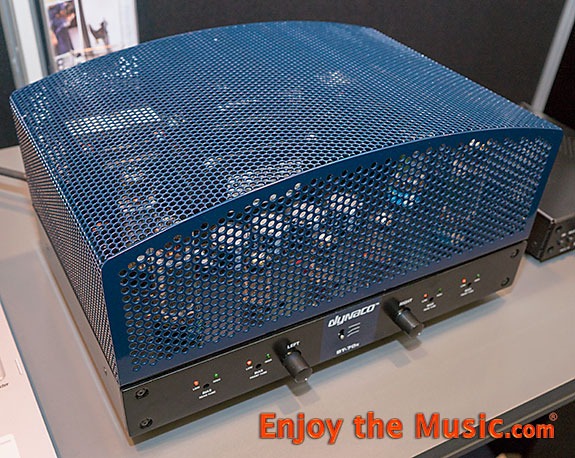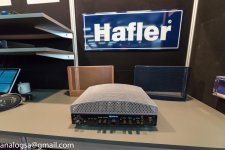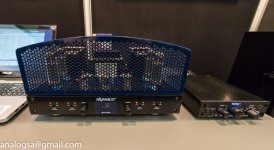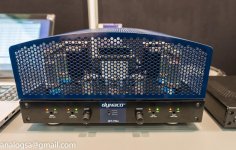If Dynaco/Hafler fans who have any technical material, please have a look at: Hafler - Perfecting hifidelity audio for over 60 years.. If you have anything that is not in our archive, we would appreciate getting a scan of it to share with the audio community. Schematics are especially appreciated as some of the manuals for later products did not have them. If you have anything, please post a notice on this forum.
The exact old look will not be possible as there is no way the original ST70 would ever have passed electrical safety rules, even back in the day. Hafler got around this by selling kits.
Pay no mind to the ST70-A, right?
An updated SCA-35 integrated amp could be a big hit over at Stereophile. Maybe with an improved driver circuit. Lower the B+ so current production JJ EL84 can be safely used. Maybe make it fixed bias, so you get a bit more power. Perhaps even with a (gasp!) solid-state phono stage, to keep costs under control...
I'd say you want to give it the visual characteristics that make an amp look like a Dynaco. That brown perforated metal tube cage with the champagne color aluminum face and blue Dynaco logo is important. If the amp looks like a classic Dynaco (even if of some indeterminate model), I don't think the general amp buying public is going to stress too much if the circuits have been changed from the originals.
Maybe give it a DAC with a USB input, for the computer audio people...
Or maybe not.
I'd say you want to give it the visual characteristics that make an amp look like a Dynaco. That brown perforated metal tube cage with the champagne color aluminum face and blue Dynaco logo is important. If the amp looks like a classic Dynaco (even if of some indeterminate model), I don't think the general amp buying public is going to stress too much if the circuits have been changed from the originals.
Maybe give it a DAC with a USB input, for the computer audio people...
Or maybe not.
We have taken a serious look at the ST-70 Series II and will be using a number of features from it. Especial attention is being paid to making the setting of the bias easier. We cannot use the drive circuit from it as it used a tube that is out of production. Though we have found some other high end circuitry that Hafler did that he did not use for reasons of cost and patent issues.
As well, we find that to get the tighter bottom end that people demand these days, we are looking at solid state rectifiers. The forward voltage drop on a tube, even the 5AR4 ,is just too high to recharge the capacitors quickly enough to give a tight bottom end. Bottom end impulse response is primarily a function of the design of the power supply.
As well, we find that to get the tighter bottom end that people demand these days, we are looking at solid state rectifiers. The forward voltage drop on a tube, even the 5AR4 ,is just too high to recharge the capacitors quickly enough to give a tight bottom end. Bottom end impulse response is primarily a function of the design of the power supply.
As for a DAC, we are in the process of designing a small DAC card for USB that can indeed go into products. A 24bit/192K unit most likely. But we expect most people would want that as an external USB to analog box to route through their preamp where they could select that or other devices rather than have it in their power amp. At the quality level we are looking at, it would add about $100 to the end user price. The debate is ongoing.
Legendary Dynaco ST70 Has Been Relaunched | The Absolute Sound


The original ST70's power supply has long been the design area most vulnerable to legitimate criticism. Dynaco has addressed this problem as follows:
... Dynaco has installed an input frequency limiting filter network to limit bandwidth to 20 to 20,000 Hz (long regarded as the human hearing range). This filter allows the removal of the tailoring components within the active circuitry and permits the active gain circuitry to be flatter across the frequency spectrum. The audible benefit is a great improvement in distortion components at the frequency extremes while still maintaining adequate bandwidth.
- Use of an entirely new and larger dual primary power transformer with improved line regulation (due to added iron in its core). It can now be wired for 220 volt / 50 Hz operation.
- The original 5AR4 tube has been replaced by Solid-State rectifiers, thus removing the 5AR4's inherent losses and reduced regulation, while eliminating a failure-prone out-of-production tube in the process.
- The original power supply filter capacitance has been made far larger. As large as we could fit in the same form factor. This has been desirable for a long time but has only recently become practical (i.e., much greater capacitance can now be packaged in casings of the same.)
- The troublesome selenium rectifier used in the bias circuitry has also been replaced by a Solid-State rectifier with additional supply capacitance.
- The filter inductor has been reduced in value to complement the increase in filter capacitance with a resulting reduction of DC resistance. This provides more voltage for use by the outputs and somewhat higher peak power output.
Hafler - Perfecting hifidelity audio for over 60 years.
I think these are the guys. Probably not some shameless vendor.
I think these are the guys. Probably not some shameless vendor.
I'm a little late to this party, here's some random mental dribblings:
The first thing I'd like to say is "what Hafler would do today" would be to build a solid state amplifier. The only reason he would build a tube amp would be to capitalize on the nostalgia side of things. He switched to solid state many many years ago and would make another solid state amp now.
The three tube triode design was done many years ago. I talked to Ned about making my own version of the board after the fire at Triode (this was in the mid 90's if I recall). Ned wasn't making boards, and lost all the originals and apparently the artwork. So I re-laid it out and also made the 6AU6 version (upon request). I sold a bunch of them to Triode over the years. Since the design pre-dated me, and I just did the grunt work to recreate it, I have no intellectual property rights over it.
And frankly there aren't any intellectual property rights on tube circuits, there is nothing even remotely new under the sun with tube circuits.
I use a four tube design for my driver circuit these days. All dual triodes.
I wish them luck with the tube amp. I wouldn't want to bring a tube amp to market with the Chinese designs nipping at my heals. As soon as the Chinese amps get good output iron they will be hard to beat from a value standpoint. Bear did a good job of looking at the economics of trying to build a product, but I'd say his parts costs are really low if they are going to use better than mediocre iron. But the trick is to put crap transformers in cans. As long as it looks good...
Also the Citation II kicks the living crap out of anything that came out of the Dynaco line. But it should be, as it was WAY more expensive then and now.
Sheldon
The first thing I'd like to say is "what Hafler would do today" would be to build a solid state amplifier. The only reason he would build a tube amp would be to capitalize on the nostalgia side of things. He switched to solid state many many years ago and would make another solid state amp now.
OK, so it's not actually an IP issue. I had trouble imagining that, since people have been doing this for 40 years or more.
Past that, since this is a commercial venture, I'm not interested in giving free design advice other than "basic Dynaco input stage topology can be made to work very well if that's what they want to do."
The three tube triode design was done many years ago. I talked to Ned about making my own version of the board after the fire at Triode (this was in the mid 90's if I recall). Ned wasn't making boards, and lost all the originals and apparently the artwork. So I re-laid it out and also made the 6AU6 version (upon request). I sold a bunch of them to Triode over the years. Since the design pre-dated me, and I just did the grunt work to recreate it, I have no intellectual property rights over it.
And frankly there aren't any intellectual property rights on tube circuits, there is nothing even remotely new under the sun with tube circuits.
I use a four tube design for my driver circuit these days. All dual triodes.
I wish them luck with the tube amp. I wouldn't want to bring a tube amp to market with the Chinese designs nipping at my heals. As soon as the Chinese amps get good output iron they will be hard to beat from a value standpoint. Bear did a good job of looking at the economics of trying to build a product, but I'd say his parts costs are really low if they are going to use better than mediocre iron. But the trick is to put crap transformers in cans. As long as it looks good...
Also the Citation II kicks the living crap out of anything that came out of the Dynaco line. But it should be, as it was WAY more expensive then and now.
Sheldon
A new company with a strong reputation in professional music has acquired the Hafler and Dynaco brands and intellectual property. I will not say who as that may be considered advertising.
Our question is:
For an ST-70 amplifier would the preference be for:
1. An amplifier as faithful to the original ST-70 but incorporating the improvements of that have been done to it by the audio community but using no New Old Stock parts. Sorry, no 7199 input. But following the original Pentode-Triode input circuit with feedback.
2. The best possible amplifier that will still use the EL34 output but where the input/driver uses new topologies for what we feel will be better sound quality. We have spoken with people who knew David Hafler and we would basically do what he would have done today if he were around. However, the signal path will still be through tubes.
Either of these made with all new parts will have an MSRP a little north of US$1200
We ask because there are so many old and rebuilt ST-70 amplifiers out there, that some here have felt that a person who wants the original 1950s sound quality will just buy one of the original or reproductions for a lower price. That a person buying a new unit wants something that is competitive with a current well rated tube amplifier.
Note that the lead engineer on this project received their basic electronics education in the 1960s on tubes and has been involved with the audiophile community for decades. This is not just some rebadging exercise.
Regardless, as a long time DIYer, I would appreciate the input of the DIY community on the approach to take. And your comments do not need to be limited to the ones I have given. For your suggestions, all I ask is that you only recommend tubes that are still in production.
Just understand that dmfraser66's company, Radial Engineering, as of 4/15/16 is being sued by Panor Corporation who AFAIK does legally own the rights to the "Dynaco" trade name. If Radial loses the suit, their "Dynaco ST-70 Series III" will not see the light of day. See law suit link below.
Radial Engineering being sued by Panor Corporation
Bob Latino
World Premiere! Hands-On Review Of The Dynaco ST-70 And ST-1 -- HIGH END 2016 Munich Audiophile Show Report

-> Radial Engineering Ltd.

Radial Engineering Ltd., which is the parent company that owns both the Hafler and Dynaco nameplates, is no stranger to audio. Have been keeping an eye on them for quite some time within the professional audio mags i read. They have been producing pro audio products for quite some time and is now (finally) concentrating their efforts to such classics as the Dynaco Stereo 70 vacuum tube amplifier...
-> Radial Engineering Ltd.
Last edited:
RIP Dynaco ST-70 Series III
The latest scoop is that this amp has been discontinued by Radial Engineering do to poor sales. They tried to take the Dynaco trade name "upscale" and failed. The interesting thing is that Panor (who used to own the Dynaco trade name) tried the same thing in 1992 > The Dynaco ST-70 Series II which sold for about $1000 USD. By the end of the '90's Panor pulled the plug on the Dynaco ST-70 Series II. $1000 in 1992 money is about $1850 USD today. What made Radial think that they could sell this amp at $3000 USD ? I will say this > It was a nice looking amp and it probably sounded really good. Last year they sold a few "on sale" at $1500 USD probably to get some of them out to customers and then jacked the price back up to $3000 USD.
I wrote to one of their marketing people by Email and he admitted that they had a lot of parts on hand and the amps were not selling. He also said that the company was sold in January of 2018 and the new owners decided to pull the plug on this amp. This is not entirely accurate since the company was sold in January of 2018 yet they started selling the amp in May of 2018 > 5 months after the sale of the company. In any event this amp is no more ... RIP Dynaco ST-70 Series III.
The latest scoop is that this amp has been discontinued by Radial Engineering do to poor sales. They tried to take the Dynaco trade name "upscale" and failed. The interesting thing is that Panor (who used to own the Dynaco trade name) tried the same thing in 1992 > The Dynaco ST-70 Series II which sold for about $1000 USD. By the end of the '90's Panor pulled the plug on the Dynaco ST-70 Series II. $1000 in 1992 money is about $1850 USD today. What made Radial think that they could sell this amp at $3000 USD ? I will say this > It was a nice looking amp and it probably sounded really good. Last year they sold a few "on sale" at $1500 USD probably to get some of them out to customers and then jacked the price back up to $3000 USD.
I wrote to one of their marketing people by Email and he admitted that they had a lot of parts on hand and the amps were not selling. He also said that the company was sold in January of 2018 and the new owners decided to pull the plug on this amp. This is not entirely accurate since the company was sold in January of 2018 yet they started selling the amp in May of 2018 > 5 months after the sale of the company. In any event this amp is no more ... RIP Dynaco ST-70 Series III.
Now you can buy clones of the original Dynaco kits. Of course you can still customize
the kits any way you want.
Amplifier Kits Archives - Dynakit Parts
the kits any way you want.
Amplifier Kits Archives - Dynakit Parts
No, the pentode input stage was not a compromise. It was a good choice to avoid miller capacitance issues that you would get from something like a 12AX7 as a first stage tube, and this helped the amp work much better with preamps of the time.
The "new and improved" ST-70 had an input impedance that was super low, IIRC it was 5K, which is a real head scratcher!
The "new and improved" ST-70 had an input impedance that was super low, IIRC it was 5K, which is a real head scratcher!
The pentode part of the input stage was a compromise. The power transformer could also have been just a bit larger.
yes, with today's sources, large gains are not mandatory...
i did an amp using the 12au7 as input voltage amp stage and a 6sl7 ltp splinter....
worked pretty well too...
- Status
- This old topic is closed. If you want to reopen this topic, contact a moderator using the "Report Post" button.
- Home
- Amplifiers
- Tubes / Valves
- Dynaco ST-70 Series III


